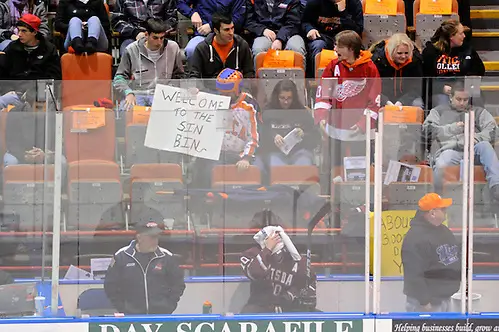
When the 2017 NCAA Division III men’s hockey championships are held this weekend in the Utica Memorial Auditorium, history will be made for only the second time.
The Aud, as it’s affectionately known, will become the second building to host both the Men’s Division I and Division III hockey championship.
The first was the Lake Placid Olympic Center Arena, now referred to as the Herb Brooks Arena, built for the 1980 Olympics and of course the home of the “Miracle on Ice.” Lake Placid held the Frozen Four in 1984 (Bowling Green over Minnesota Duluth, 5-4, in the famous four-overtime marathon) and 1988 (Lake Superior State beat St. Lawrence, 4-3, again in overtime).
It then became a semi-permanent host for Division III starting in 2008. D-III will return to Lake Placid next year for the seventh time. It also hosted the 2007 women’s Frozen Four (Wisconsin over Minnesota Duluth, 4-1), making it the only building to hold three different college hockey national championships.
The Frozen Four was also held in Lake Placid’s original Olympic Rink built for the 1932 Olympics, now called the Jack Shea Arena, in 1970. That was the year Cornell finished off a 29-0-0 perfect season by beating Clarkson, 6-4.
Now, it’s Utica’s turn.
The Utica Aud was a design ahead of its time. Ground broke in 1957, but the Aud did not open till March 13, 1960, almost exactly three years later. It was the world’s first pre-stressed dual-cable roof system, designed by esteemed architect Lev Zetlin, who also did the New York State Pavilion “Tent of Tomorrow” seen at the 1964 World’s Fair.
This design, which used struts between the cables, influenced many other dome structures, including today’s Madison Square Garden. This design enabled it to be only the third arena at the time without any obstructed views.
The innovative cable suspended roof was finally recognized in 2011 by the American Society of Civil Engineers, designating it a National Historic Civil Engineering Landmark. New York’s Museum of Modern Art recognizes the arena as an architectural landmark, displaying photos and renderings in its permanent collection.
Two years after opening, the Aud hosted the 1962 Frozen Four. Only four teams qualified for the national tournament at that time. St. Lawrence (ECAC) and Michigan Tech (WCHA) got the automatic bids as conference tournament champions. Another ECAC North Country team, Clarkson, along with WCHA’s Michigan, got the at-large bids.
Clarkson, who was the number one seed in the East, squeaked by Michigan, 5-4, while Michigan Tech had no trouble with St. Lawrence, 6-1. Michigan Tech did one better in the championship game, besting Clarkson 7-1. Michigan beat St. Lawrence, 5-1, in the third-place game.
Red Berenson was a forward on that Michigan squad and made the All Tournament Team. Len Ceglarski was the coach for Clarkson. The Most Outstanding Player was Lou Angotti. John MacInnes was the winning coach.
The attendance for the final game was reported at 4,210 … in a place which lists its hockey capacity at 3,860.
Hockey has played a prominent role in Utica. ACHL, NEHL, UHL, and AHL pro franchises (the Comets being the latest) called the Aud their home over the years. Utica hosted the State high school championship from its inception through 2015. Local high schools use it, as does the Jr. Comets youth program, and, occasionally, Mohawk Valley Community College.
Some of the action scenes in the iconic hockey movie Slap Shot were filmed in the Aud.
College hockey returned to Utica in earnest in 2001 when Utica College formed a men’s and women’s program. Renovations were made to give the college teams their own locker rooms, offices, and training room. The Pioneers have been hugely successful, often selling out the place, leading the nation in Division III attendance many times. This attendance was able to be maintained even after the AHL returned to Utica in 2013.
It was this local support for college hockey that led the NCAA to return a championship after 55 years, putting the Utica Memorial Auditorium in the same company as the Herb Brooks Arena, a company of two.
New York State and college hockey hosting tidbits
– Even though Colorado hosted the most Frozen Fours (thanks to 11 in the Broadmoor Ice Palace) with 14, New York (second with 10) hosted the Frozen Four in more cities (6) and buildings (7) than any other state — the aforementioned three in two buildings in Lake Placid and the one in Utica, twice each in Syracuse (Onondaga War Memorial) and Albany (Knickerbocker Arena/Pepsi Arena now known as Times-Union Center), and once each in Buffalo (HSBC Arena, now KeyBank Center) and Troy (RPI Field House).
– New York also dominates hosting the Division III national championship. Two factors help. One, New York has the most D-III programs, so when the host site was on campus locations, odds were New York would have a team ranked high enough to host. Two, Lake Placid being selected as a neutral site so many times. In total, including 2017 and 2018, New York has hosted 18 times in six different cities in seven different buildings.
– The D-III breakdown for New York hosting, again including the next two years, is Lake Placid (7), RIT (3), Plattsburgh (3), Elmira (2 in Murray Athletic Center and one in First Arena), Union (1), and Utica (1). (Note: the most times an on campus site hosted is Middlebury, Vermont, with four, which they did in two different buildings which held two each.)
– Thanks to Plattsburgh’s and Elmira’s domination in women’s hockey, New York easily leads all the Division III women’s championship hosting categories. New York hosted a total of 11 times in three locations — Plattsburgh (6), Elmira (3), and RIT (2). Those three sites, along with Middlebury and Wisconsin-Superior, have hosted D-III championships in both genders.
– On the flip side, New York only hosted one Women’s Frozen Four, the one in Lake Placid.


